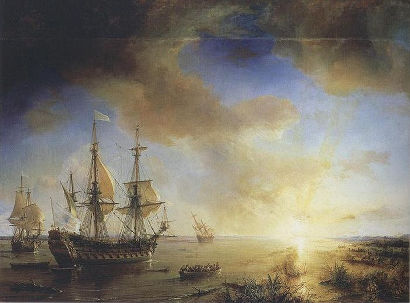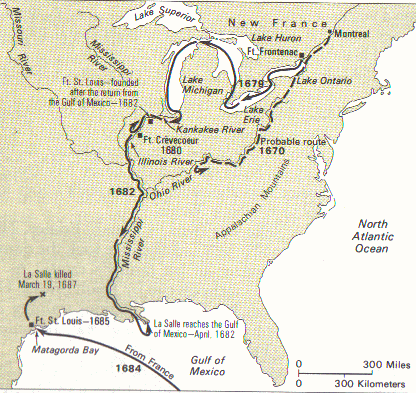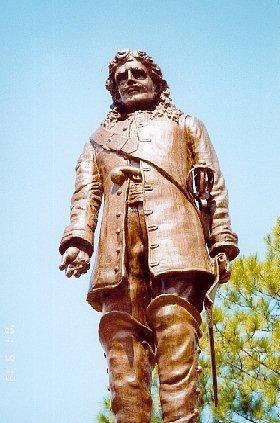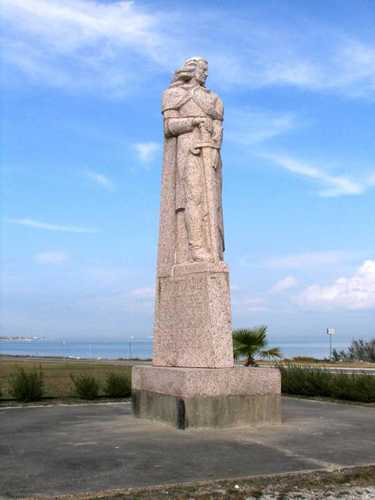|
Books by
Jeffery Robenalt
|
|
As
a young man in France, Rene-Robert Cavelier de La Salle was ordained
as a priest by the Society of Jesus. However, after confessing that
he was unsuited to the life of a cleric, the Jesuits released him
from his vows. In the spring of 1666, nearly destitute from the vow
of poverty he had taken when he joined the Society, La Salle embarked
on a voyage to Canada where he joined his brother who had moved to
the colony of Montreal the year before. From the beginning of his
adventure in the New World, the young man was enthralled with the
vast unmapped lands of the North American continent.
After spending nearly three years exploring the territory surrounding
his own land grant on the western end of the Island of Montreal, and
studying the languages of the local native peoples, La Salle learned
of a great river some distance to the south the Indians called the
Ohio. The Frenchman’s first serious exploration was a 1669 expedition
to the Ohio. His plan was to follow the downstream course of the river,
hoping that it would flow into the Mississippi and eventually on into
the Gulf of Mexico. Unfortunately, the falls at the present day site
of Louisville, Kentucky, proved impassable for his boats and prevented
the expedition from continuing any further. |
 |
Rene-Robert Cavelier
de La Salle
Wikimedia Commons |
For the next
several years, in addition to his many business ventures, La Salle
explored the entire southern region of the Great Lakes. These efforts
culminated in a major expedition to determine once and for all whether
the Mississippi River flowed into the Gulf of Mexico as he had always
surmised. Departing from present day Fort Wayne, Indiana, his expedition
canoed down the entire length of the Mississippi and reached the Gulf
in April, 1682. La Salle buried an engraved plaque and a cross at
the mouth of the river, claiming the entire Mississippi Basin for
France and naming it La Louisiane in honor of his sovereign,
King Louis XIV.
Excited by his discovery, La Salle returned to France, determined
to convince the king that a French colony must be established on the
Gulf of Mexico at the mouth of the Mississippi. From such a colony
France would be in position to control the shipment of goods from
the interior of the continent, harass Spanish shipping in the Gulf,
or even launch an invasion of New Spain if it became necessary. King
Louis agreed and on July 24, 1684, La Salle set sail from the French
port of La Rochelle with high hopes and a fleet of four ships and
280 men. Unfortunately, the expedition would suffer many misfortunes
along the way. |
 |
La Salle's Expedition
to Louisiana in 1684
1844 painting by Jean Antoine Théodore de Gudin.
Left - La Belle. Middle - Le Joly. Right - L'Aimable
Wikimedia
Commons |
Bad luck began
early before La Salle’s small fleet reached the Gulf of Mexico, when
Spanish buccaneers attacked and captured the Saint Francois
off the island of Hispaniola. Then after entering the Gulf and diligently
searching the coast for hundreds of miles, the Frenchman was unable
to locate the mouth of the Mississippi River. Using the navigation
instruments of the day, a ship’s captain could be relatively certain
of his latitude, that is how far north or south of the equator his
ship was, but until the invention of an accurate clock that could
be used at sea, his position east or west was at best an educated
guess. For La Salle, this problem was compounded by the lack of a
proper map and the expansive delta system at the mouth of the Mississippi
River that seemed to offer a thousand dead ends to the entrance of
the mighty river.
Faced with these problems, it was no wonder that instead of the mouth
of the Mississippi, La Salle’s three remaining ships made landfall
in January 1685, on the desolate coast of Texas, some 400 miles further
to the west than their intended target. Misfortune continued when
L’Aimable, the expedition’s supply vessel, ran aground while
trying to enter Matagorda Bay. Most of the expedition’s supplies were
lost when the ship broke apart and sank. Le Joly, the warship
scheduled to return to France once the expedition reached the mouth
of the Mississippi, then sailed for home with the majority of crewmen
from L’Aimable and a few settlers who decided at the last minute
not to remain in the New World.
After the departure of Le Joly, La Salle sailed La Belle,
his remaining ship, into Matagorda Bay and a few miles up present
day Garcitas Creek in Victoria County where he established the little
settlement that has come to be known as Fort
St. Louis. Although referred to as a “fort”, there were none
of the usual trappings usually associated with such structures. Instead
of a sturdy palisade or defensible wall, there were only a few crude
wooden huts with thatch roofs scattered around a clearing. One of
the primitive huts served as the settlement’s chapel, the first house
of worship built in present day Texas
that was not situated on the Rio Grande. |
 |
Map of La Salle's
Expeditions
Courtesy The Robinson Library - www.robinsonlibrary.com |
Soon the French
made contact with the Karankawa who were friendly at first, inviting
the strangers to their village. However, when the French discovered
the Indians had salvaged some of the provisions that washed ashore
from the wrecked supply ship, they demanded that the Karankawa return
them. Of course, the Indians refused and fighting broke out. Several
Frenchmen were either killed or wounded before they made it back to
their settlement, and from then on a state of hostilities existed
between the French and the Karankawa.
Facing increased pressure from the savage Indians and a shortage of
supplies, La Salle made La Belle ready for sea and moved the
ship to an anchorage he assumed was safe. He was planning to make
a search by sea for the elusive mouth of the Mississippi. However,
before embarking on this vitally important voyage he made a mysterious
trek to the west, leaving the ship in the hands of some unreliable
seaman. While La Salle was gone the seaman ran short of water and
decided to weigh anchor and move the ship to a more favorable location.
During what should have been a simple maneuver, a fierce northerly
wind arose and the inept crewmen were unable to work the rigging.
In desperation they dropped the bow anchor, but the wind was such
that it failed to hold. The ship was driven southward across the bay,
the anchor dragging the bottom until the wounded vessel slammed into
a barrier of sand known today as Matagorda Peninsula and slowly sank.
With their last ship at the bottom of the bay and no help from the
Native Texans, conditions became extremely difficult for La Salle’s
colony. Drought ruined their crops and many colonists became ill or
simply wandered away, never to be heard from again. By October of
1685, the colony was in desperate need of supplies, and La Salle decided
to take a small party and attempt to seek a land route to the mouth
of the Mississippi. Setting out with his brother and fifty men, he
traveled down the Lavaca River and then eastward on foot, but he was
unsuccessful and returned to Fort St. Louis in late March of 1686,
having lost most of his men. In April, La Salle tried again, but after
reaching the Sabine River with twenty men, he once again returned
to the fort, this time with only eight survivors.
By late 1686, only forty-five French colonists were still alive. The
others had either died from disease or been killed by the Karankawa.
On January 12, 1687, La Salle decided to take twenty of the survivors
and make one last desperate attempt to reach the Mississippi. Many
of the men argued against this decision, and a few of the dissenters
hatched a plot to kill La Salle. He was shot by one of his own men
on March 19, 1687, near present day Navasota.
A statue was dedicated there in his memory. |
 |
Led
by Henri Joutel, seven survivors, including La Salle’s brother, eventually
made their way back to Canada. In 1688, Joutel journeyed to France
to ask King Louis to send a rescue mission to Texas,
but the king decided that France had already spent too much money
exploring the Gulf of Mexico. Left stranded and alone, most of the
remaining settlers either died of sickness or were massacred by the
Karankawa. Six French children were the exception, five of them from
the Talon family. The Karankawa adopted and raised the children, and
ten years later they were discovered by the Spanish and taken to Mexico
City.
Although La Salle’s expedition to establish a colony at the mouth
of the Mississippi River was unsuccessful, his explorations were of
great importance to Texas. The French presence in Texas
finally stirred the Spanish to action. Fearing they would lose the
race to claim the Americas, the Spaniards renewed their exploration
of the Gulf Coast and began working diligently to settle east
Texas.
Over the years, the location of Fort
St. Louis and the site of the sinking of La Belle have
been the subjects of intense historical interest. In fact, much speculation
still centered on the location of the fort even though a preliminary
archeological study identified numerous French artifacts on the site.
It took the discovery of La Salle’s eight cannons buried on a private
ranch in Victoria
County to capture the interest of the archeologists from the Texas
Historical Commission and finally set them to work uncovering the
historical treasures of the site. |
 |
Likewise, in
1995, after years of diligent but unsuccessful searching, a crew of
archeologists from the Commission discovered the wreck of La Belle
all but swallowed up for 310 years in the mud of Matagorda Bay.
The archeological crew confirmed the age and identity of the wreck
by examining one of the ship’s elaborately inscribed cannons. Excavating
the shipwreck required a remarkable and expensive effort, but to date
more than a million artifacts have been conserved and catalogued.
Eventually the reconstructed Belle will be placed on exhibit
in the Bob Bullock Texas State History Museum in Austin.
An exhibit in Texas Beyond History, La Belle Shipwreck, and
a companion exhibit, Fort St. Louis, offer much more detailed information
on these delightful historical subjects.
© Jeffery
Robenalt
"A Glimpse of Texas Past"
July 1, 2011 Column
jeffrobenalt@yahoo.com |
|
|
